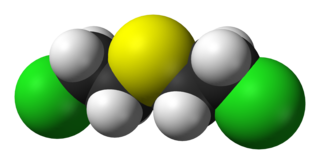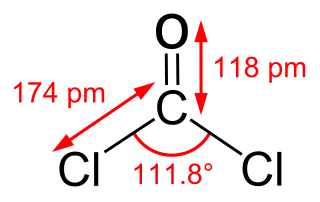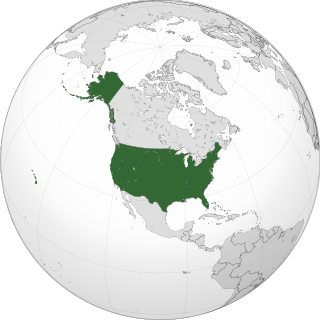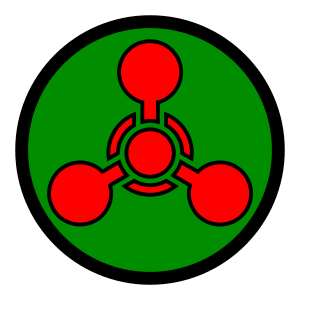
Mustard gas or sulfur mustard are names commonly used for the organosulfur chemical compound bis(2-chloroethyl) sulfide, which has the chemical structure S(CH2CH2Cl)2, as well as other species. In the wider sense, compounds with the substituents −SCH2CH2X or −N(CH2CH2X)2 are known as sulfur mustards or nitrogen mustards, respectively, where X = Cl or Br. Such compounds are potent alkylating agents, which can interfere with several biological processes. Also known as mustard agents, this family of compounds comprises infamous cytotoxins and blister agents with a long history of use as chemical weapons. The name mustard gas is technically incorrect; the substances, when dispersed, are often not gases but a fine mist of liquid droplets. Sulfur mustards are viscous liquids at room temperature and have an odor resembling mustard plants, garlic, or horseradish, hence the name. When pure, they are colorless, but when used in impure forms, such as in warfare, they are usually yellow-brown. Mustard gases form blisters on exposed skin and in the lungs, often resulting in prolonged illness ending in death.

Phosgene is an organic chemical compound with the formula COCl2. It is a toxic, colorless gas; in low concentrations, its musty odor resembles that of freshly cut hay or grass. It can be thought of chemically as the double acyl chloride analog of carbonic acid, or structurally as formaldehyde with the hydrogen atoms replaced by chlorine atoms. Phosgene is a valued and important industrial building block, especially for the production of precursors of polyurethanes and polycarbonate plastics.

Chemical warfare (CW) involves using the toxic properties of chemical substances as weapons. This type of warfare is distinct from nuclear warfare, biological warfare and radiological warfare, which together make up CBRN, the military acronym for chemical, biological, radiological, and nuclear, all of which are considered "weapons of mass destruction" (WMDs), a term that contrasts with conventional weapons.

The use of toxic chemicals as weapons dates back thousands of years, but the first large-scale use of chemical weapons was during World War I. They were primarily used to demoralize, injure, and kill entrenched defenders, against whom the indiscriminate and generally very slow-moving or static nature of gas clouds would be most effective. The types of weapons employed ranged from disabling chemicals, such as tear gas, to lethal agents like phosgene, chlorine, and mustard gas. These chemical weapons caused medical problems. This chemical warfare was a major component of the first global war and first total war of the 20th century. The killing capacity of gas was profound, with about 90,000 fatalities from a total of 1.3 million casualties caused by gas attacks. Gas was unlike most other weapons of the period because it was possible to develop countermeasures, such as gas masks. In the later stages of the war, as the use of gas increased, its overall effectiveness diminished. The widespread use of these agents of chemical warfare, and wartime advances in the composition of high explosives, gave rise to an occasionally expressed view of World War I as "the chemist's war" and also the era where weapons of mass destruction were created.

Porton Down is a science and defence technology campus in Wiltshire, England, just north-east of the village of Porton, near Salisbury. It is home to two British government facilities: a site of the Ministry of Defence's Defence Science and Technology Laboratory – known for over 100 years as one of the UK's most secretive and controversial military research facilities, occupying 7,000 acres (2,800 ha) – and a site of the UK Health Security Agency. Since 2018, part of the campus has housed Porton Science Park, which is owned and operated by Wiltshire Council and has private sector companies in the health, life science and defence and security sectors.

The United States is known to have possessed three types of weapons of mass destruction: nuclear, chemical, and biological weapons. As the country that invented nuclear weapons, the U.S. is the only country to have used nuclear weapons on another country, when it detonated two atomic bombs over two Japanese cities of Hiroshima and Nagasaki during World War II. It had secretly developed the earliest form of the atomic weapon during the 1940s under the title "Manhattan Project". The United States pioneered the development of both the nuclear fission and hydrogen bombs. It was the world's first and only nuclear power for four years, from 1945 until 1949, when the Soviet Union produced its own nuclear weapon. The United States has the second-largest number of nuclear weapons in the world, after the Russian Federation.

The United Kingdom possesses, or has possessed, a variety of weapons of mass destruction, including nuclear, biological, and chemical weapons. The United Kingdom is one of the five official nuclear weapon states under the Treaty on the Non-Proliferation of Nuclear Weapons. The UK renounced the use of chemical and biological weapons in 1956 and subsequently destroyed its general stocks.

Many nations continue to research and/or stockpile chemical weapon agents despite numerous efforts to reduce or eliminate them. Most states have joined the Chemical Weapons Convention (CWC), which required the destruction of all chemical weapons by 2012. Twelve nations have declared chemical weapons production facilities and six nations have declared stockpiles of chemical weapons. All of the declared production facilities have been destroyed or converted for civilian use after the treaty went into force.

Although Germany has the technical capability to produce weapons of mass destruction (WMD), since World War II it has refrained from producing those weapons. However, Germany participates in the NATO nuclear weapons sharing arrangements and trains for delivering United States nuclear weapons. Officially, 20 US-nuclear weapons are stationed in Büchel, Germany. It could be more or fewer, but the exact number of the weapons is a state secret.

In violation of the Geneva Protocol of 1925, the Iraqi Army initiated two failed and one successful (1978–1991) offensive chemical weapons (CW) programs. President Saddam Hussein (1937–2006) pursued the most extensive chemical program during the Iran–Iraq War (1980–1988), when he waged chemical warfare against his foe. He also used chemicals in 1988 in the Al-Anfal Campaign against his civilian Kurdish population and during a popular uprising in the south in 1991.
Hugo Gustav Adolf Stoltzenberg was a German chemist associated with the German government's clandestine chemical warfare activities in the early 1920s.
Chemical terrorism is the form of terrorism that uses the toxic effects of chemicals to kill, injure, or otherwise adversely affect the interests of its targets. It can broadly be considered a form of chemical warfare.

The 15 cm Nebelwerfer 41 was a German multiple rocket launcher used in the Second World War. It served with units of the Nebeltruppen, German Chemical Corps units that had the responsibility for poison gas and smoke weapons that were also used to deliver high-explosives during the war. The name Nebelwerfer is best translated as "smoke thrower".

A chemical weapon (CW) is a specialized munition that uses chemicals formulated to inflict death or harm on humans. According to the Organisation for the Prohibition of Chemical Weapons (OPCW), this can be any chemical compound intended as a weapon "or its precursor that can cause death, injury, temporary incapacitation or sensory irritation through its chemical action. Munitions or other delivery devices designed to deliver chemical weapons, whether filled or unfilled, are also considered weapons themselves."
The United States chemical weapons program began in 1917 during World War I with the creation of the U.S. Army's Gas Service Section and ended 73 years later in 1990 with the country's practical adoption of the Chemical Weapons Convention. Destruction of stockpiled chemical weapons began in 1986 and was completed on July 7, 2023. The U.S. Army Medical Research Institute of Chemical Defense (USAMRICD), at Aberdeen Proving Ground, Maryland, continues to operate.
Chemical weapons have been a part of warfare in most societies for centuries. However, their usage has been extremely controversial since the 20th century.

The Small Box Respirator (SBR) was a British gas mask of the First World War and a successor to the Large Box Respirator. In late 1916, the respirator was introduced by the British with the aim to provide reliable protection against chlorine and phosgene gases. The respirator offered a first line of defence against these. The use of mustard gas, was begun by the Germans; a vesicant ("blister agent") that burnt the skin of individuals that were exposed to it. Death rates were high with exposure to both the mixed phosgene, chlorine and mustard gas, however with soldiers having readily available access to the small box respirator, death rates had lowered significantly. Light and reasonably fitting, the respirator was a key piece of equipment to protect soldiers on the battlefield.

RAF Bowes Moor was a chemical warfare agent (CWA) storage site run by the Royal Air Force during and after the Second World War. The site was to the north of the village of Bowes in what is now County Durham, England. The Bowes Moor geographical feature runs from the north to the south west of the village. The Royal Air Force used the site to stock its chemical weapon supply, most of which was disposed of in situ by burning. The site, which closed in 1947, is known for the dangerous chemicals which leached into the soil.












